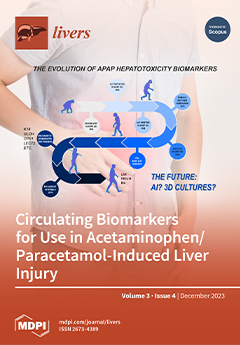Open AccessArticle
The 863C>A and 1031T>C Single Nucleotide Polymorphisms (SNPs) in the Tumor Necrosis Factor Alpha (TNF-α) Promoter Gene May Not Be Putative Predictors of HBV Endemicity
by
Hussein Mukasa Kafeero, Dorothy Ndagire, Ponsiano Ocama, Charles Drago Kato, David Patrick Kateete, Abdul Walusansa, Ali Kudamba, Kigozi Edgar, Fred Ashaba Katabazi, Maria Magdalene Namaganda, Jamilu E. Ssenku, Eddie Wampande, Henry Kajumbula and Hakim Sendagire
Viewed by 1296
Abstract
Background: Genetic polymorphisms within the gene loci of the promoter region of tumor necrosis factor (TNF) alpha have been associated with the pathogenesis of hepatitis B virus (HBV) infection. In Uganda, there is a wide variation in the HBV endemicity, ranging from low
[...] Read more.
Background: Genetic polymorphisms within the gene loci of the promoter region of tumor necrosis factor (TNF) alpha have been associated with the pathogenesis of hepatitis B virus (HBV) infection. In Uganda, there is a wide variation in the HBV endemicity, ranging from low endemicity, through moderate endemicity, to hyper-endemicity. However, the underlying reasons for this disparity in HBV burden are not fully elucidated. Thus, we aimed to test the hypothesis that the TNF-α-863C/A and -1031T/C polymorphic sites may have an effect on the difference between the burden of HBV in our country. We screened 384 participants, from which a sample of 134 was drawn, to determine the HBV, TNF-α-863C/A, and TNF-α-863T/C genotypes. The nucleotide BLAST was used to match the unknown targeted sequence obtained from the Sanger sequence against the known deposited sequence. This process unveiled the base substitution mutation and the HBV genotypes. The odds ratio (OR) and Chi-square test of proportions were used for the analysis. All the analyses were performed using SPSS version 26.0 and MedCalc software version 20.010 at 95% CI. A
p < 0.05 was considered statistically significant. Results: The prevalence of both the TNF-α-863C/A and the TNF-α-1031T/C genotypes and their alleles did not differ significantly by endemicity (
p > 0.05). However, the prevalence of the nucleotide substitution mutations for TNF-α-863C>A and TNF-α-1031T>C was significantly low for all the study groups (
p < 0.05). Conclusion: The TNF-α gene promoter at the TNF-α-863C/A and 1031T/C positions is conserved in our population and may not affect the endemicity of HBV infection. However, future research should focus on the use of nationwide samples in order to reach concreate determinations regarding the role of the TNF-α polymorphisms in the risk/resolution of HBV infections in an African or Black population.
Full article
►▼
Show Figures





